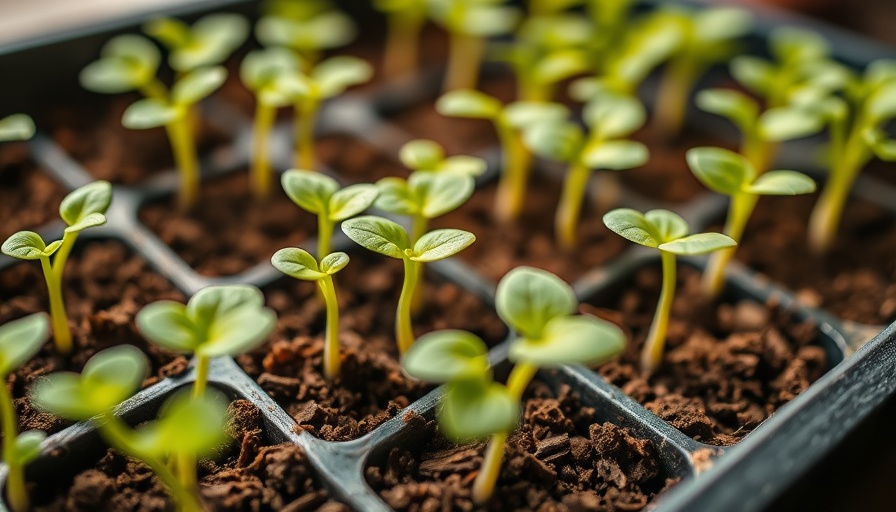
Unlocking the Secrets of Indoor Seed Starting
The journey of plant growth begins long before seeds touch the soil—they first need the right environment to thrive. For homeowners with gardens, starting seeds indoors not only accelerates growth but also expands the gardening palette. As many plant enthusiasts already know, this amazing technique is particularly beneficial for warmer-weather crops like tomatoes, eggplants, and peppers. But why exactly is indoor sowing so essential? Let’s delve deeper into its benefits.
In 'Why you should start seeds indoors?', the discussion dives into the benefits of indoor seed starting, exploring key insights that sparked deeper analysis on our end.
A Head Start For Your Garden
Indoor seed starting gives your plants a significant advantage when it’s time to move them outside. By nurturing them indoors, gardeners can help them get stronger and hardier before exposing them to the unpredictable outdoor climate. Late frosts or sudden temperature swings can be detrimental for young plants, making indoor sowing a safeguard against potential setbacks.
Furthermore, starting seeds indoors allows for an early planting schedule, meaning crops can be harvested earlier in the season. For example, gardeners who start their tomato seeds indoors can transplant them outside earlier, resulting in a more fruitful growing season. This leads to a bountiful harvest, allowing you to share the fruits of your labor with family and friends.
Variety is the Spice of Gardening
Another significant advantage of starting seeds indoors is the variety of plants you can cultivate. While many gardeners are familiar with the annual struggles of growing traditional crops, indoor sowing opens the door to a multitude of plant varieties. From exotic peppers to specialty heirloom tomatoes, the choice is vast. This diversity not only enhances your garden's visual appeal but also invites more unique flavors to your kitchen. So, while you coax those young seedlings into life, you can prepare your palate for extraordinary culinary adventures ahead.
Essential Knowledge for Indoor Sowing
Understanding the basics of indoor seed starting can make the difference between a successful garden and a disappointing experience. Soil, water, light, and temperature play pivotal roles in seed germination and growth. Here are a few key tips to consider:
- Soil: Choose high-quality seed starting mix to provide optimal conditions for seed germination.
- Water: Keep soil moist (but not soggy); overwatering can lead to mold and root rot.
- Light: Ensure seedlings receive adequate light to grow strong—consider using grow lights if natural light is insufficient.
- Temperature: Most seeds germinate best in temperatures between 65°F and 75°F.
Beyond the Basics: Long-Term Benefits
As beneficial as starting seeds indoors may initially seem, the long-term effects are just as compelling. First and foremost, it promotes sustainability. By starting your seeds and nurturing them, you minimize the carbon footprint associated with buying commercial seedlings. In an era of heightened environmental awareness, this practice aligns beautifully with sustainable gardening efforts.
Moreover, developing the skill to start seeds indoors fosters a deeper connection with nature. Gardening, at its core, is a nurturing process that reconnects you with the cycles of growth and seasons. As homeowners watch their plants thrive, the appreciation for nature and the environment often grows exponentially. It’s a satisfaction that can’t be replicated by store-bought produce.
Overcoming Common Misconceptions
Many first-time gardeners worry that starting seeds indoors will be too complicated or time-consuming. However, the opposite is often true. Once you establish a routine, seed starting can be a quick and enjoyable process. Additionally, the fear of failure can deter gardeners from attempting this method. While it’s true that some seeds may not germinate, learning from these experiences and altering practices can lead to greater success in subsequent seasons. Perseverance is key in gardening, as with many aspects of life.
Join the Seed Starting Revolution
In today’s fast-paced world, where local produce can be inconvenient to obtain, taking responsibility for your food source through gardening provides empowerment. Starting seeds indoors gives you complete control over what you grow, ensuring that your fruits and vegetables are free from harmful chemicals and pesticides. It’s a nurturing process that simultaneously benefits your health and the environment.
If you're enthusiastic about creating a sustainable living environment and ensuring the quality of your homegrown produce, we encourage you to explore indoor seed starting further. Gardening may not just be a hobby; it can evolve into a fulfilling lifestyle choice. Happy gardening!
 Add Row
Add Row  Add
Add 




Write A Comment